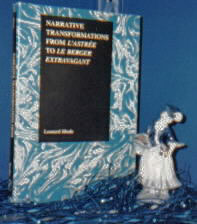Narrative Transformations from L'Astrée to Le berger extravagant
Leonard Hinds
In this comparative study of Honoré d'Urfé's L'Astrée and Charles Sorel's Le berger extravagant, Leonard Hinds examines the historical transition from the idealist, pastoral romance to the more realist antiromance. His analysis of the literary conventions shared by both of these seventeenth-century works traces the transformation of poetic forms, courtly language, polemics, emblematic representation, and character depiction in Sorel's parody of the pastoral. Basing his inquiry on the theories of discourse of Mikhail Bakhtin and Julia Kristeva, Hinds focuses on the linguistic transformation of source texts in L'Astrée and the altering of d'Urfé's language in Le berger. His study of narrative themes such as the echo myth, verbal disguise, discursive travesty, and cross-dressing demonstrates their adaptation in the pastoral romance and its parody. Hinds considers the figure of the tomb and the motif of death as means to figure a Baroque notion of authorship and to express pre-classical literary criticism. Finally at issue is the influence of this romance and antiromance on the development of criticism of the novel and the formation of seventeenth-century French fiction.
"Hinds's study makes an important contribution to studies on the early-seventeenth-century novel. His analysis of the two novels is carried out in two broad and important contexts: sixteenth- and early-seventeenth-century French literature in general (Baroque esthetic theory, the literary controversies of the time, etc.) and modern critical theory (Bakhtin, Kristeva, Benjamin, Foucault, etc.). The author brings all of these elements together in a coherent, intelligent, and thought-provoking manner." Richard G. Hodgson, author of Falsehood Disguised: Unmasking the Truth in La Rochefoucauld
"In this study of Honore d'Ufre's early seventeenth-century pastoral novel, L'Astrée, and Charles Sorel's parody of it, Le Berger extravagant, Leonard Hinds uses as a starting point the critical theories of Bakhtin and Kristeva.... Hinds explores a number of key themes in both novels. These include verbal echoes, travesties, and disguises; the use of debate, emblem, and allegory; the mutliple possiblities of transvestism and narcissism in the definition of an elusive self-identity; and the layered meanings, both negative and positive, in the tomb image.... Hinds provides much information on the history of the pastoral genre, on the Baroque in literature, and also on the critical writings about both." James P. Gilroy, French Review
For complete review see French Review 77.3 (2003-04): 587-88.
"Il saggio di Hinds, supportato da un'ampia bibliografia critica riportata in appendice, ribadisce dunque non solo la centralita di queste due opere nel panorama letterario del primo Seicento, ma anche il rilievo e l'influenza che ebbero sulla formazione e lo sviluppo della narativa barocca e classica." Chiara Rolla, Studi Francesi
For complete review see Studi Francesi 47.2 (May-August 2003): 436-37.
For another review, see Reference & Research Book News 1 Aug. 2002.
Leonard Hinds, Indiana University, has published articles on Montaigne, Théophile de Viau, Honoré d'Urfé, Charles Sorel, Madeleine de Scudéry, and Ninon de Lenclos.
1-55753-235-4
2002.Vol. 24. x, 203 pp. Cloth $54.95

Image from a display case in Stanley
Coulter Hall, Purdue University,
March 2002.
Information last updated June 24, 2015
For further information about this book, contact the production editor at clawsons@purdue.edu